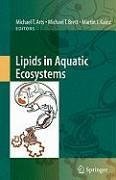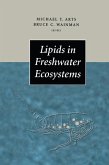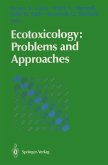Lipids in Aquatic Ecosystems provides a comprehensive summary of the most recent literature on the role of lipids in aquatic systems from many world experts. Essential fatty acids (EFAs), or omega-3 and omega-6 fatty acids as they are known in the popular press, have garnered considerable attention in the technical and popular literature during the last decade. Lipids are important energy storage molecules in most organisms. However, equally or even more important, specific lipids (e.g. EFAs) play critical roles in a wide range of physiological processes such as regulating the structural properties of cell membranes and serving as precursors to eicosanoid signaling molecules (i.e. prostaglandins, prostacyclins, the thromboxanes and the leukotrienes). It is well established the EFAs have important impacts on human health, and it is widely agreed that the classic "Western diet" is particularly imbalanced vis-à-vis foods containing omega-3 versus omega-6 fatty acids. But beyond the specialist literature, it is not widely known that the most physiologically important long chain, polyunsaturated omega-3 fatty acids, i.e. eicosapentaenoic acid (EPA) and docosahexaenoic acid (DHA) are produced de novo principally by aquatic algae. Furthermore, within aquatic ecosystems these molecules may be synthesized from precursor fatty acid molecules and/or concentrated as they are conveyed to animals consumed by humans. For example, in salmonid fish DHA and EPA constitute ~40% of total fatty acids, whereas in typical marine and freshwater phytoplankton EPA and DHA account for between 2% and 20% of total fatty acids. In humans, EPA and DHA play key roles in heart health, immune and inflammatory responses, visual acuity as well being major components of neurological tissues such as the brain and spinal cord. This realization has prompted great concern in the fisheries management community that the world's natural supply of EPA and DHA is being overexploited. There is also concern that global climate change and/or eutrophication processes may be modifying the production and availability of these molecules in aquatic ecosystems.
Tremendous strides, as summarized in this book, have been made in our understanding of the specific enzymatic pathways by which various lipids are synthesized by producers and transformed by consumers within aquatic ecosystems. Recent research also indicates that in addition to EFAs, phyto-sterol lipids may play critical roles in the nutritional physiology aquatic fauna. This book also has state-of-the-art chapters on the utility of fatty acids are biomarkers of material and energy transfer in aquatic ecosystems. Primary producers at the base of aquatic food webs generally have distinctive fatty acid profiles and many studies have shown that these fatty acid "signatures" can be used as tracers of food web dynamics. Lipids also play important roles in the trophic transfer of a variety of lipid-soluble persistent organic pollutants, and selectively accumulate even with non-lipid soluble contaminants such as the powerful neurotoxin methyl mercury. Certain fatty acids may also serve as the substrates from which some toxins and allelopathic metabolites are produced.
This book will be of interest to a wide range of scientists from the fields of marine and freshwater plankton ecology, algal physiology, fisheries management, nutritional science, food web ecology, aquaculture, toxicology, and environmental science.
Michael T. Arts is a research scientist with Environment Canada at the National Water Research Institute in Burlington, Ontario, Canada.
Michael T. Brett is a professor in the Department of Civil and Environmental Engineering at the University of Washington in Seattle.
Martin J. Kainz is a research scientist at the WasserCluster - Biologische Station Lunz; an inter-university center dedicated to freshwater sciences research and education, inLunz am See, Austria.
Tremendous strides, as summarized in this book, have been made in our understanding of the specific enzymatic pathways by which various lipids are synthesized by producers and transformed by consumers within aquatic ecosystems. Recent research also indicates that in addition to EFAs, phyto-sterol lipids may play critical roles in the nutritional physiology aquatic fauna. This book also has state-of-the-art chapters on the utility of fatty acids are biomarkers of material and energy transfer in aquatic ecosystems. Primary producers at the base of aquatic food webs generally have distinctive fatty acid profiles and many studies have shown that these fatty acid "signatures" can be used as tracers of food web dynamics. Lipids also play important roles in the trophic transfer of a variety of lipid-soluble persistent organic pollutants, and selectively accumulate even with non-lipid soluble contaminants such as the powerful neurotoxin methyl mercury. Certain fatty acids may also serve as the substrates from which some toxins and allelopathic metabolites are produced.
This book will be of interest to a wide range of scientists from the fields of marine and freshwater plankton ecology, algal physiology, fisheries management, nutritional science, food web ecology, aquaculture, toxicology, and environmental science.
Michael T. Arts is a research scientist with Environment Canada at the National Water Research Institute in Burlington, Ontario, Canada.
Michael T. Brett is a professor in the Department of Civil and Environmental Engineering at the University of Washington in Seattle.
Martin J. Kainz is a research scientist at the WasserCluster - Biologische Station Lunz; an inter-university center dedicated to freshwater sciences research and education, inLunz am See, Austria.
Dieser Download kann aus rechtlichen Gründen nur mit Rechnungsadresse in A, B, BG, CY, CZ, D, DK, EW, E, FIN, F, GR, HR, H, IRL, I, LT, L, LR, M, NL, PL, P, R, S, SLO, SK ausgeliefert werden.
From the reviews:
"The book ... cover the role of lipids from lower to higher trophic levels. ... Each chapter starts with a well-drafted introduction to the topic, and finishes with a conclusion that opens the door for future research in the field. ... this book should appeal to plankton ecologists, nutritionists, aquaculturists, toxicologists, environmental chemists and environmental managers. I would add that it should also appeal to lipid educators ... . easy to read volume that should be in the shelves of most lipid chemists' libraries." (Néstor M. Carballeira, Lipids, Vol. 44, 2009)
"The chapters of the book progress logically through the origins of lipids in aquatic environments ... . Lipids derived from aquatic ecosystems are vitally important for human health and the chapter detailing these issues will provide a useful justification for funding from grant awarding bodies. Overall, the book with its extensive summary of the current literature is essential reading for researchers with an interest in the ecological biochemistry of aquatic organisms and will provide an invaluable baseline for future studies in this field." (D. W. Pond, Journal of Plankton Research, October, 2009)
"It is a very good attempt to provide an update on the role of lipids in the growth and reproduction of organisms in aquatic environments in general. ... The book broadly sums up the recent literature on the role of lipids in different types of aquatic systems. ... The present book has an extended scope because it includes studies on lipids in both freshwater and marine ecosystems. ... I enjoyed every bit of reading the book ... ." (Ramesh D. Gulati, Aquatic Ecology, Vol. 43, 2009) "This new book is an attempt to establish a general reference for all aquatic systems and covers a wide range of topics ... . The book is intended for a large audience: academics and graduate students, but also government researchers and resource managers. ... will be extremely useful for students and all researchers in need of a good introduction but also in need of clarifications on the possibilities and limitations of the different approaches one might consider. ... also appeal to readers from related disciplines." (Patrick Mayzaud, Limnology and Oceanography Bulletin, Vol. 18 (4), December, 2009)
"The book ... cover the role of lipids from lower to higher trophic levels. ... Each chapter starts with a well-drafted introduction to the topic, and finishes with a conclusion that opens the door for future research in the field. ... this book should appeal to plankton ecologists, nutritionists, aquaculturists, toxicologists, environmental chemists and environmental managers. I would add that it should also appeal to lipid educators ... . easy to read volume that should be in the shelves of most lipid chemists' libraries." (Néstor M. Carballeira, Lipids, Vol. 44, 2009)
"The chapters of the book progress logically through the origins of lipids in aquatic environments ... . Lipids derived from aquatic ecosystems are vitally important for human health and the chapter detailing these issues will provide a useful justification for funding from grant awarding bodies. Overall, the book with its extensive summary of the current literature is essential reading for researchers with an interest in the ecological biochemistry of aquatic organisms and will provide an invaluable baseline for future studies in this field." (D. W. Pond, Journal of Plankton Research, October, 2009)
"It is a very good attempt to provide an update on the role of lipids in the growth and reproduction of organisms in aquatic environments in general. ... The book broadly sums up the recent literature on the role of lipids in different types of aquatic systems. ... The present book has an extended scope because it includes studies on lipids in both freshwater and marine ecosystems. ... I enjoyed every bit of reading the book ... ." (Ramesh D. Gulati, Aquatic Ecology, Vol. 43, 2009) "This new book is an attempt to establish a general reference for all aquatic systems and covers a wide range of topics ... . The book is intended for a large audience: academics and graduate students, but also government researchers and resource managers. ... will be extremely useful for students and all researchers in need of a good introduction but also in need of clarifications on the possibilities and limitations of the different approaches one might consider. ... also appeal to readers from related disciplines." (Patrick Mayzaud, Limnology and Oceanography Bulletin, Vol. 18 (4), December, 2009)









